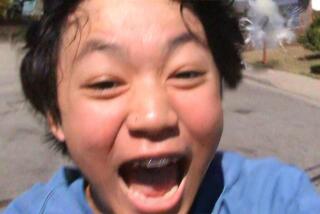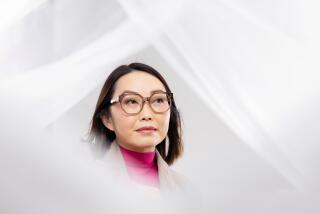Prodigy Dazzles With Skill in Traditional Painting : Art: China’s Wang Yani, the youngest person to have a solo show at the Smithsonian, is back in the U.S. to promote a new book about her life and the works she has been making since the age of 2.
- Share via
NEW YORK — It takes about 40 minutes for Wang Yani to complete a brush painting in front of an audience. First, she kneels expressionlessly before a blank sheet of rice paper with her brushes and ink to her right. She starts by painting a tree trunk that extends diagonally across the canvas in black.
Soon, underneath the tree, red cranes appear in the lower left-hand corner. Then, in the top right-hand corner, a maze of branches take shape. Minutes later, the branches begin to flower. Above the flowers, the 16-year-old splatters drops of paint that create a snowy sky.
She finishes by writing her name vertically on the right in Chinese characters, then affixing seals in red ink to the corners.
In a year that has celebrated such prodigies as Wolfgang Amadeus Mozart, teen-age tennis gladiator Jennifer Capriati and “Little Man Tate,” Wang Yani at 16 fits right into the mold.
Two years ago, she became the youngest person ever to be given a solo exhibition at the Smithsonian Institution when a show of her paintings opened at the Arthur M. Sackler Gallery for Asian art in Washington.
The shy teen-ager, who tugs at her father’s arm when she’s not painting, has now been to the United States four times and made several trips to Western Europe, dazzling crowds with her facility in traditional Chinese painting.
Eighth-graders from a school in New York’s Chinatown were dazzled when Yani painted animals in a landscape recently at the Children’s Museum of Manhattan.
Anne Liu, 13, came to New York from China with her family three years ago, but can’t remember when she’d ever seen a landscape back home like the one Yani had painted. “I’ve only seen it on TV,” she said, as she approached Yani for an autograph.
Without breaking her vacant gaze, Yani answered “no” to another teen-ager who asked whether she liked rock ‘n’ roll.
Wang Yani is back in the United States to promote a new book for children on her life and the paintings she has been making since the age of 2, “A Young Painter: The Life and Paintings of Wang Yani--China’s Extraordinary Young Artist” by Zheng Zhensun and Alice Low.
On a tour sponsored in part by the official Xinshua News Agency, Yani explained through a translator that her approach to painting has remained the same from the time she started. “I still paint according to my own ideas,” she said.
The book, written after a six-week visit to Wang Yani’s family home in rural Guocheng by the journalist and photographer Zheng Zhensun, paints a picture of an ever-smiling child nurtured by a loving family. Yani’s father is a self-taught artist who has given up oil painting to help promote his daughter’s career. He promises to return to painting once she’s grown, but says he stopped temporarily so his style wouldn’t shape hers.
The book traces his daughter’s career from an early painting of a cat walking, done when Yani was 3, through countless images of birds, water buffalos, landscapes and especially monkeys that Yani has done over the years. At the end is a chapter on traditional Chinese painting materials.
“I’ve painted people, but not as much as I’ve painted animals,” Yani whispered through a translator in an interview, “but I’m painting more people now.”
“If you see a monkey in the center of a painting, it’s usually Yani depicting herself,” added her father.
Besides being prodigious, Yani is also prolific. At 16, she has now completed more than 10,000 paintings, although she admits she’s lost count. With the exception of a few works done on visits overseas and donated to foreign institutions, none of those paintings have been sold. The works are stored near the family’s home in Guocheng by her father. “They are Yani’s diary,” he said. “Selling a painting would be like selling a page of her diary.”
So far, the “diary” has developed a huge following. Still, according to Sackler Gallery curator Jan Stuart, who organized Yani’s Washington exhibition two years ago, the teen-ager remains a riddle. “She defies us,” the authors of the newly published book quote Stuart as saying. “We are always charting influences from the past, but with Yani such influences do not exist.”
Even among other Chinese artists, from whom praise for officially sponsored work does not come easily, Wang Yani is seen as more than the Jennifer Capriati of the art world. “She is very talented,” said Zhang Hong Tu, a painter from Beijing who now works in New York, “but this is what you would have to call performance art, doing a painting in such a short time in front of an audience.” Zhang thought Wang Yani’s talents might develop better if she were left alone to paint for a few years.
Lu Hong, a graduate of China’s elite Zhenchiang Academy also now working in New York, acknowledged Wang Yani’s prodigious output, which in sheer physical terms, Lu says, would have been impossible when she was learning to draw in her home city of Hanzhou. “When I was young,” said Lu, “I had no chance to work with traditional materials such as ink and rice paper. They were too expensive. We weren’t a poor family, but if we had bought art materials, we couldn’t have bought food. We would have been hungry.”
What troubles expatriate Chinese artists most is the notion of a 16-year-old prodigy who challenges the traditional Chinese conception of painting as a process studied for decades. They warn that Wang Yani’s freedom to paint and travel--referred to in “The Young Painter” as “a game of endless joy”--should not be confused with freedom for Chinese artists. Whereas the Sackler Gallery featured Wang Yani’s work as evidence of a lifting of limits on cultural expression in China, artists insist that’s far from true.
“It’s very nice to see a young girl painting happy animals,” says Lu Hong, “but the controls are still strong.”
What does the future hold for the wunderkind ? Her biographers intone solemnly that “in the future, her soul--her inner being--and her creativity must be protected, so that she can continue to paint spontaneously, expressing her joy, anger, and sorrow.”
When asked about what less-happy themes might emerge in her future work, Yani looked at her father, “I never paint sad pictures,” the 16-year-old replied, “but some are quieter than others.”
More to Read
The biggest entertainment stories
Get our big stories about Hollywood, film, television, music, arts, culture and more right in your inbox as soon as they publish.
You may occasionally receive promotional content from the Los Angeles Times.










